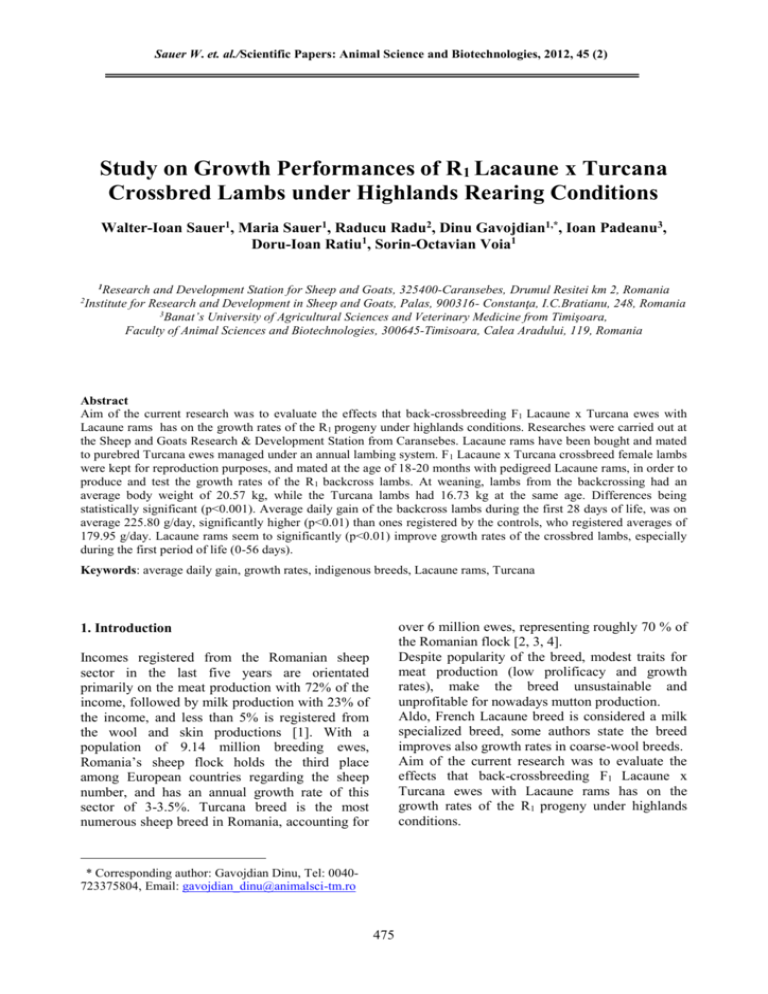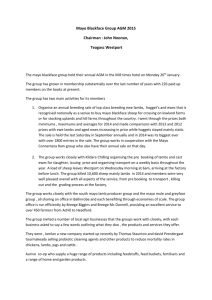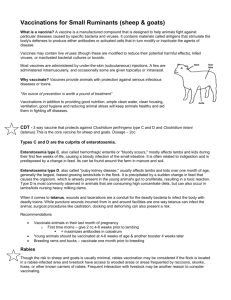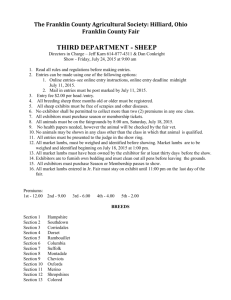Preliminary researches on the effect of essential oils on moulds
advertisement

Sauer W. et. al./Scientific Papers: Animal Science and Biotechnologies, 2012, 45 (2) Study on Growth Performances of R1 Lacaune x Turcana Crossbred Lambs under Highlands Rearing Conditions Walter-Ioan Sauer1, Maria Sauer1, Raducu Radu2, Dinu Gavojdian1,*, Ioan Padeanu3, Doru-Ioan Ratiu1, Sorin-Octavian Voia1 1 2 Research and Development Station for Sheep and Goats, 325400-Caransebes, Drumul Resitei km 2, Romania Institute for Research and Development in Sheep and Goats, Palas, 900316- Constanţa, I.C.Bratianu, 248, Romania 3 Banat’s University of Agricultural Sciences and Veterinary Medicine from Timişoara, Faculty of Animal Sciences and Biotechnologies, 300645-Timisoara, Calea Aradului, 119, Romania Abstract Aim of the current research was to evaluate the effects that back-crossbreeding F1 Lacaune x Turcana ewes with Lacaune rams has on the growth rates of the R1 progeny under highlands conditions. Researches were carried out at the Sheep and Goats Research & Development Station from Caransebes. Lacaune rams have been bought and mated to purebred Turcana ewes managed under an annual lambing system. F 1 Lacaune x Turcana crossbreed female lambs were kept for reproduction purposes, and mated at the age of 18-20 months with pedigreed Lacaune rams, in order to produce and test the growth rates of the R1 backcross lambs. At weaning, lambs from the backcrossing had an average body weight of 20.57 kg, while the Turcana lambs had 16.73 kg at the same age. Differences being statistically significant (p<0.001). Average daily gain of the backcross lambs during the first 28 days of life, was on average 225.80 g/day, significantly higher (p<0.01) than ones registered by the controls, who registered averages of 179.95 g/day. Lacaune rams seem to significantly (p<0.01) improve growth rates of the crossbred lambs, especially during the first period of life (0-56 days). Keywords: average daily gain, growth rates, indigenous breeds, Lacaune rams, Turcana 1. Introduction over 6 million ewes, representing roughly 70 % of the Romanian flock [2, 3, 4]. Despite popularity of the breed, modest traits for meat production (low prolificacy and growth rates), make the breed unsustainable and unprofitable for nowadays mutton production. Aldo, French Lacaune breed is considered a milk specialized breed, some authors state the breed improves also growth rates in coarse-wool breeds. Aim of the current research was to evaluate the effects that back-crossbreeding F1 Lacaune x Turcana ewes with Lacaune rams has on the growth rates of the R1 progeny under highlands conditions. Incomes registered from the Romanian sheep sector in the last five years are orientated primarily on the meat production with 72% of the income, followed by milk production with 23% of the income, and less than 5% is registered from the wool and skin productions [1]. With a population of 9.14 million breeding ewes, Romania’s sheep flock holds the third place among European countries regarding the sheep number, and has an annual growth rate of this sector of 3-3.5%. Turcana breed is the most numerous sheep breed in Romania, accounting for * Corresponding author: Gavojdian Dinu, Tel: 0040723375804, Email: gavojdian_dinu@animalsci-tm.ro 475 Sauer W. et. al./Scientific Papers: Animal Sciences and Biotechnologies, 2012, 45 (2) week of life, until the group were weighing around 30 kg, after that they were fed only fresh pasture feed, throughout rotational grazing on natural, unimproved highland typical pastures. Growth performance recordings were registered in lamb during morning time, at the same hour each time, using an electronically scale which had a precision of 0.05 kg. Mann Whitney test was used for testing the differences between the experimental groups. 2. Materials and methods The study was carried out at the Research and Development Station for Sheep and Goats in Caransebes, for a period of 4 years. At the beginning of the experiment, two Lacaune rams have been bought and mated to purebred Turcana ewes managed under an annual lambing system. F1 Lacaune x Turcana crossbreed female lambs were kept for reproduction purposes, and mated at the age of 18-20 months with pedigreed Lacaune rams, in order to produce and test the growth rates of the R1 backcross lambs. As controls, purebred Turcana lambs were used in the study. Both crossbreds and purebreds were kept in the same housing and management condition. Lambs were weaned at the age of 60 days, and received daily rations of 250 g concentrates starting the second 3. Results and discussion In Table 1 are being presented body weight of R1 LAx[LAxTA] backcross and Turcana lambs at birth, 28, 56 and 90 days of age. Table 1. Body weight of R1 LAx[LAxTA] and TA lambs at birth, 28, 56 and 90 days of age (kg) Trait n X ± SEM SD V% R1 Lax(LAxTA) (at birth) [A] 20 3.65±0.110 0.49 13.44 TA (at birth) [B] 14 3.45±0.114 0.42 12.37 A vs. B ns R1 Lax(LAxTA) (at 28 d) [C] 20 9.97±0.234 1.04 10.51 TA (at 28 d) [D] 14 8.49±0.178 0.66 7.83 C vs. D *** R1 Lax(LAxTA) (at 56 d) [E] 20 15.47±0.263 1.17 7.59 TA (at 56 d) [F] 14 12.25±0.241 0.90 7.36 E vs. F *** R1 Lax(LAxTA) (at 90 d) [G] 20 20.57±0.336 1.50 7.31 TA (at 90 d) [H] 14 16.73±0.321 1.20 7.18 G vs. H *** At birth, crossbred lambs registered an average body weight of 3.65 kg, non-significantly different (p≥0.05) compared to purebred Turcana lambs, who registered an average birth weight of 3.45 kg. Genotype din not had a major role in the trait. Body weight of the backcross lambs at the age of 28 days of life was on average 9.97 kg, significantly higher (p<0.001) the purebred Turcana lambs, who registered on average 8.49 kg. At the age of 56 days, average body weights ware of 15.47 kg in crossbreds lambs and of 12.25 kg in controls, differences registered being statistically significant (p<0.001). At weaning, lambs from the backcrossing had an average body weight of 20.57 kg, while the Turcana lambs had 16.73 kg at the same age. Differences being statistically significant (p<0.001). Table 2 presents data regarding average daily gains of the R1 LA x[LA x TA] backcross and purebred Turcana lambs during the researches ongoing. Average daily gain of the backcross lambs during the first 28 days of life, was on average 225.80 g/day, significantly higher (p<0.01) than ones registered by the controls, who registered averages of 179.95 g/day. During the 28-56 days of life, genotype had a significant role (p<0.01) for the average daily gain trait, Lacaune sired lambs registered averages of 196.50 g/day, while Turcana lambs from the control groups registered on average 134.30 g/day. During the last testing period, between 56-and 90 days of life, backcross lambs registered on average 150.16 g/day, while the control lambs registered on average 131.70 g/day. Differences 476 Sauer W. et. al./Scientific Papers: Animal Sciences and Biotechnologies, 2012, 45 (2) between the two genotypes were non-significant (p≥0.05). Aldo R1 backcrosses are being produce to further develop a composite population with good dairy aptitudes, because half of the progeny will be males, the growth rates of lambs is a very important trait, since they will be marketed for slaughter. Table 2. Average daily gain of the R1 LAx[LAxTA] backcross and purebred TA lambs (g) Trait n X ± SEM SD V% R1 La x(LAxTA) (ADG 0-28 d) [A] 20 225.80±0.010 0.04 20.18 TA (CG) [B] 14 179.95±0.008 0.03 16.81 A vs. B ** R1 Lax(LAxTA) (ADG 28-56 d) [C] 20 196.50±0.013 0.05 30.13 TA (CG) [D] 14 134.30±0.013 0.04 36.52 C vs. D ** R1 Lax(LAxTA) (ADG 56-90 d) [E] 20 150.16±0.009 0.04 27.52 TA (at 56 d) [F] 14 131.70±0.012 0.04 35.42 E vs. F ns higher returns in farms that will practice this crossbreeding scheme. 4. Conclusions At weaning, lambs from the backcrossing had an average body weight of 20.57 kg, while the Turcana lambs had 16.73 kg at the same age. Differences being statistically significant (p<0.001). Average daily gain of the backcross lambs during the first 28 days of life, was on average 225.80 g/day, significantly higher (p<0.01) than ones registered by the controls, who registered averages of 179.95 g/day. Lacaune rams seem to significantly (p<0.01) improve growth rates of the crossbred lambs, especially during the first period of life (0-56 days). Aldo R1 backcrosses are being produce to further develop a composite population with good dairy aptitudes, because half of the progeny will be males, the growth rates of lambs is a very important trait, since they will be marketed for slaughter, and good growth rates could bring Acknowledgements This work was financed by the Sectorial Plan ADER 2020 founded by the Romanian Ministry of Agriculture and Rural Development, throughout Romanian Academy of Agricultural Sciences and Forestry, project code 7 DDZ, number ADER 733. References 1. Padeanu, I., Meat production in sheep (in Romanian), Mirton Publishing, Timisoara, 2010, pp 3-5 2. Voia, S.O., Practical guide for sheep and goats breeding (in Romanian), Waldpress Publishing, Timisoara, 2002, pp. 53-56 3. Daraban, S., Coroian, C., Georgescu, B., Cluj Merino breeds’ potential for meat production, ABAH Bioflux, 2009, 1, 57-62 4. Ilisiu, E., Daraban, S., Neascu, G., Ilisiu, V., Rahman G., Improvement of lamb production in Romania by crossbreeding of local Tsigai breed with high performance breeds, Landbauforschung – vTI, Agriculture and Forestry Research, 2010, 60, 259-266 477




